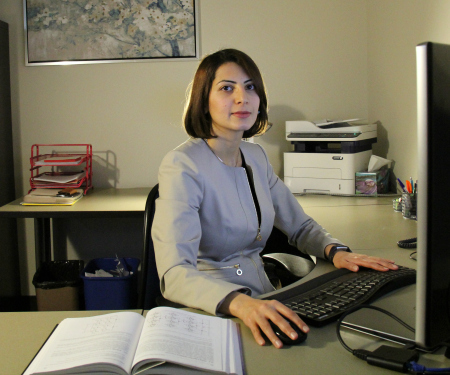
POWERFUL PRIZE: Electrical engineering professor Sahar Pirooz Azad has been granted $200,000 for specialized power grid system equipment, and is one of six UAlberta engineering researchers who garnered funding from the Canada Foundation for Innovation.
(EDMONTON) Researchers at the University of Alberta Faculty of Engineering garnered funding for sophisticated equipment to advance discoveries in areas as diverse as mechatronics, food security and more robust power distribution systems.
Six engineering researchers are being awarded a total of more than $560,000 from the Canada Foundation for Innovation's John R. Evans Leaders Fund (JELF). They are among 14 UAlberta researchers who together received $2.1 million.
"I'm proud to be part of a government that values scientists," said Amerjeet Sohi, federal Minister of Infrastructure and Communities, who spoke at the funding announcement. "I hope the investment announced today will inspire a new generation of young explorers in the fields of science, technology, engineering and mathematics."
Among the recipients of the JELF award is one such "young explorer," electrical engineering professor Sahar Pirooz Azad who will receive nearly $200,000 for a Real Time Digital Simulator-a specialized computing platform that can simulate detailed power systems models in real-time. It can carry out large-scale power system analyses, as well as enable component design and validation.
"We've seen a growth in the number of high-voltage direct current (HVDC) power transmission lines across Alberta, like the new ones between Edmonton and Calgary, which were commissioned at the end of 2015," said Pirooz Azad. "That is a $3.5-billion investment and it's part of a trend of adding HVDC lines to reinforce the existing alternating current (AC) power systems against the increased demand for electricity in central and southern Alberta and to decrease the risk of outages. Over time, we believe we will see a blended AC-DC system."
Her lab's Real Time Digital Simulator will enable researchers and industry partners to model the behaviour of electrical grid components operating in a blended system, allowing them to accurately control the grid to provide a safe and secure source of energy.
This equipment represents the first university-based real-time digital simulation facility with capability to adequately model and simulate large transmission-level and distribution-level electrical networks-providing support to local industry for testing physical equipment under real world conditions. Until now, this testing was carried out by a private-sector contractor. Now that the U of A has the equipment, industry and university researchers can collaborate more easily.
"It's expensive equipment and some utilities have it but most research institutions don't," Pirooz Azad said. "With this equipment, Canadian students and local industry will benefit from access to the range of research and training activities that the real-time simulator will offer." The infrastructure will establish the U of A as a leading power systems research and testing facility in Canada and internationally.
She and her co-principal investigator, electrical engineering professor Gregory Kish, will be able to conduct "hardware-in-loop" experiments, in which they field test equipment on a simulated grid to make sure it will operate as expected. And it if doesn't, they can create new algorithms enabling it to function properly.
Total costs for the project are about $460,000. The two researchers are receiving a 20-per-cent matching grant from Manitoba-based RTDS Technologies, which manufactures the equipment, and they're awaiting word on the remaining funding through the Alberta Economic Development and Trade Small Equipment Grants Program.
Pirooz Azad received her PhD in Electrical Engineering, specializing in power systems, from the University of Toronto in 2013. Her doctoral research focused on designing control schemes to prevent power grid instability and large-scale blackouts. She was a post-doctoral fellow at the Centre for Applied Power Electronics (CAPE) at the University of Toronto in 2014 and later won the Marie Sklodowska-Curie Actions scholarship from European Commission. She joined the University of Alberta in 2015.
Other Faculty of Engineering JELF funding recipients are:
- Hyo-Jick Choi, Department of Chemical and Materials Engineering, $85,830 for a micro-milling workstation to develop solid-type vaccines;
- Dominic Sauvageau, Department of Chemical and Materials Engineering, $105,001 for development, characterization and analysis of native and engineered microbial systems;
- Mahdi Tavakoli, Department of Electrical and Computer Engineering, $84,793 for a facility for robot-assisted rehabilitation, therapy, and surgery;
- Mohtada Sadrzadeh, Department of Mechanical Engineering, $40,803 to help develop antifouling thin film nanocomposite membranes; and
- Martin Barczyk, Department of Mechanical Engineering, supporting automation of mechatronic systems.